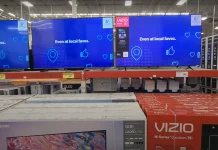Both models belong to Samsung’s premium QLED series and feature Quantum Dot technology, providing a 10-bit color depth and the ability to display over a billion shades. While their specifications are quite similar, there are a few key differences between them.
Main Differences Between Samsung Q8 and Q80
The most significant upgrade in the 2019 Q80 model is the addition of built-in support for Google Assistant and Amazon Alexa, which is absent in the 2018 Q8. This makes the Q80 more convenient for smart home integration. Another difference is the operating system version. The Q80 runs on Tizen 5.0, which improves voice command functionality and includes minor optimizations, while the Q8 operates on an earlier version. However, in everyday use, the difference is barely noticeable.
Both TVs feature full-array local dimming technology, though they are marketed under different names. The Q80 uses the term Direct Full Array 8X³, while the Q8 is labeled as Full Array Backlight. Despite the name change, the underlying technology remains the same. The same applies to local dimming: Ultimate UHD Dimming in the Q80 and Supreme UHD Dimming in the Q8 offer virtually identical performance.
Regarding color processing, Samsung uses different marketing terms for the same technology. The Q80 features 100% Color Volume with Quantum Dot, while the Q8 is labeled Q Color, but there is no difference in actual color reproduction. HDR technology is also unchanged. The Q80 is marketed with Quantum HDR 12X, while the Q8 is labeled with Q HDR Elite. However, both models deliver the same HDR performance, with identical brightness and contrast levels.
Compare parameters Q8 vs Q80 in the table
| QN65Q80RAFXZA (2019) | QN65Q8FNBFXZA (2018) | |
| screen | ||
| Screen Size | 64.5″ | 64.5″ |
| Resolution | 3,840 x 2,160 | 3,840 x 2,160 |
| screen bit | 10bit | 10bit |
| type screnn | Quantum Dot | Quantum Dot |
| screen technology | VA | VA |
| Backlighting | Direct Full Array 8X³ | Full Array Backlight |
| Dimming Technology | Ultimate UHD Dimming | Supreme UHD Dimming |
| Stand Type (Color) | Flat Foot | Simple |
| Bezel Width | 4 Bezel-less | 4 Bezel-less |
| Video | ||
| Motion Rate | 240 | 240 |
| refresh rate | 120 | 120 |
| Color | 100% Color Volume with Quantum Dot¹ | Q Color |
| HDR (High-Dynamic Range) | Quantum HDR 12X⁸ | Q HDR Elite |
| Picture Engine | Quantum Processor 4K | Quantum Processor 4K |
| Audio | ||
| Dolby | Yes | Yes |
| Sound Output | 40W | 40W |
| Woofer | Yes | Yes |
| Speaker Type | 4.1CH | 4.1CH |
| Multiroom Link | Yes | Yes |
| Features | ||
| OS | Tizen 5.0 | Tizen 4.0 |
| Wi-Fi | Yes | Yes |
| Bluetooth | Yes | Yes |
| Smart Hub | Yes | Yes |
| Bixby | Yes | Yes |
| Digital Clean View | Yes | Yes |
| Ultra Black | Ultra Black Elite | Ultra Black Elite |
| ConnectShare | Yes | Yes |
| Closed Captioning | Yes | Yes |
| Game Mode | Yes | Yes |
| Eco Sensor | Yes | Yes |
| Mobile to TV – Mirroring, DLNA | Yes | Yes |
| Google Assistant | Yes | No |
| Alexa | Yes | No |
| Auto Channel Search | Yes | Yes |
| InstaPort S (HDMI Quick Switch) | Yes | Yes |
| Channel Guide | Yes | Yes |
| Ambient Mode | Yes | Yes |
| Auto Power Off | Yes | Yes |
| AI Technology | Yes | No |
| Apps Platform | Smart TV with Bixby Voice, Apps and Full Web Browser | Smart TV with Bixby Voice, Apps and Full Web Browser |
| Auto Motion Plus | Yes | Yes |
| Embedded POP | Yes | Yes |
| Anynet+™ (HDMI-CEC) | Yes | Yes |
| V-Chip | Yes | Yes |
| TV to Mobile – Mirroring | Yes | Yes |
| USB HID Support | Yes | Yes |
| AI Upscale | Yes | Yes |
| Easy Pairing | No | Yes |
| Inputs & Outputs | ||
| HDMI | 4 | 4 |
| USB | 2 | 2 |
| Ethernet | Yes | Yes |
| RF In (Terrestrial/Cable | Yes | Yes |
| RF In (Satellite Input) | Yes | Yes |
| Digital Audio Out (Optical) | Yes | Yes |
| Audio Return Channel Support | Yes | Yes |
| Dimensions | ||
| Product Size (W x H x D) Without Stand | 57.1″ x 32.7″ x 2.4″ | 57.1″ x 32.6″ x 2.3″ |
| Product Size (W x H x D) With Stand | 57.1″ x 35.3″ x 12.1″ | 57.1″ x 35.8″ x 11.6″ |
| Product Weight With Stand | 56.9 lb. | 59.7 lb |
| System | ||
| Digital Broadcasting | ATSC/ClearQAM | ATSC/ClearQAM |
| Analog Tuner | Yes | Yes |
| Accessories | ||
| Remote control | TM1950C | TM1850A |






